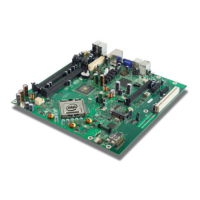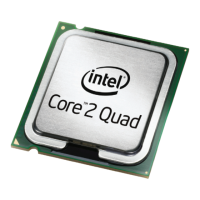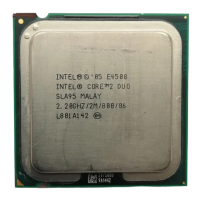Sensor Based Thermal Specification Design Guidance
50 Thermal/Mechanical Specifications and Design Guidelines
7.2.2 Specification When DTS value is Greater than T
CONTROL
The product specification provides a table of Ψ
CA
values at DTS = T
CONTROL
and
DTS = -1 as a function of T
AMBIENT
(inlet to heatsink). Between these two defined
points, a linear interpolation can be done for any DTS value reported by the processor.
A copy of the specification is provided as a reference in Tabl e 7- 1 of Section 7.6.
The fan speed control algorithm has enough information using only the DTS value and
T
AMBIENT
to command the thermal solution to provide just enough cooling to keep the
part on the thermal profile.
As an example the data in Tab l e 7 - 1 has been plotted in Figure 7-3 to show the
required Ψ
CA
at 25, 30, 35, and 40°C T
AMBIENT
. The lower the ambient, the higher the
required Ψ
CA
, which means lower fan speeds and reduced acoustics from the processor
thermal solution.
In the prior thermal specifications this region, DTS values greater than T
CONTROL
, was
defined by the processor thermal profile. This required the user to estimate the
processor power and case temperature. Neither of these two data points are accessible
in real time for the fan speed control system. As a result the designer had to assume
the worst case T
AMBIENT
and drive the fans to accommodate that boundary condition.
Figure 7-3. Thermal solution Performance
0.300
0.350
0.400
0.450
0.500
0.550
0.600
0.650
0.700
DTS = Tcontrol DTS = -1
TTV Theta_ca [C/W]
Ta = 40 °C
Ta = 35 °C
Ta = 30 °C
Ta = 25 °C
TTV Ψ_ca @
TTV Ψ_ca @

